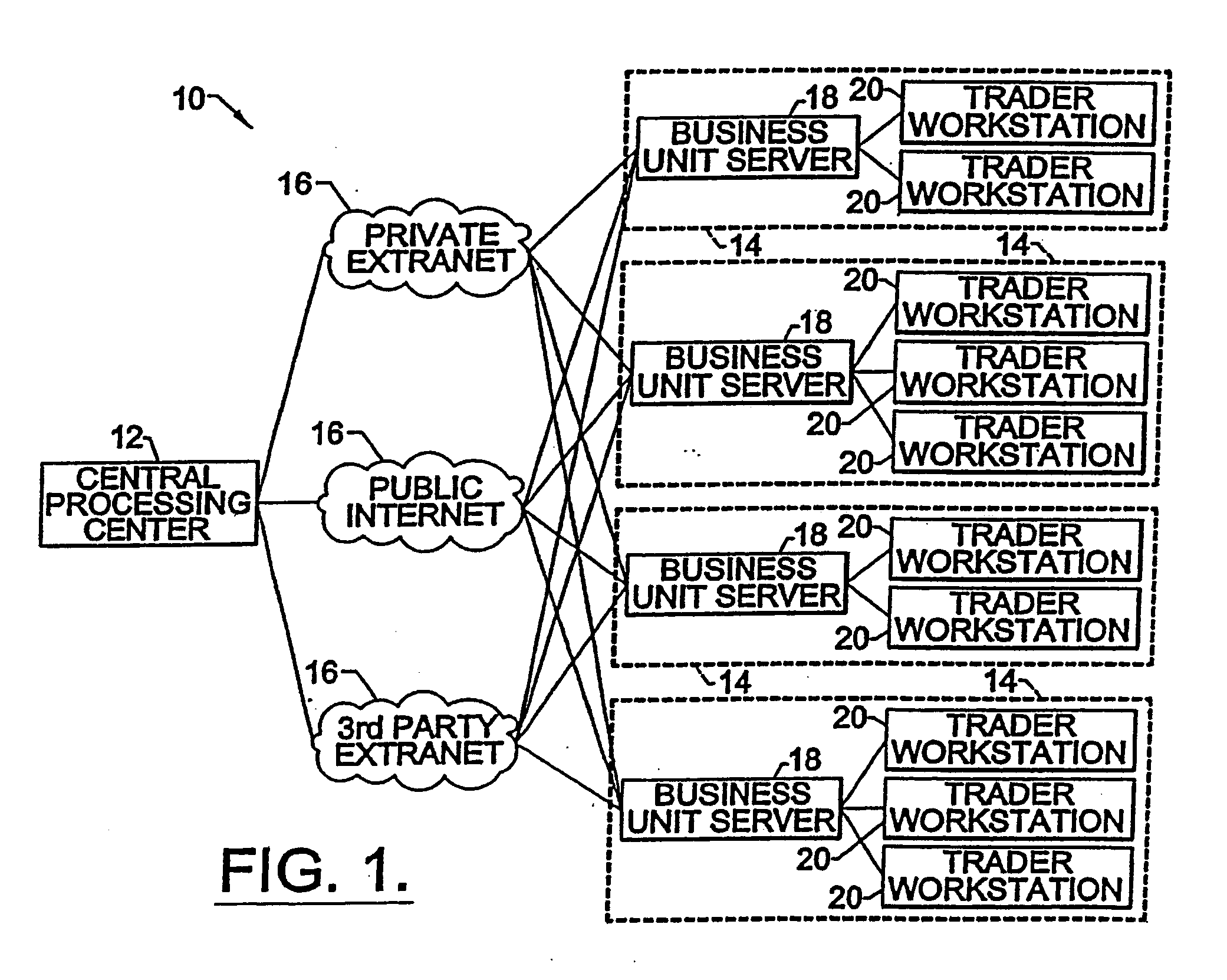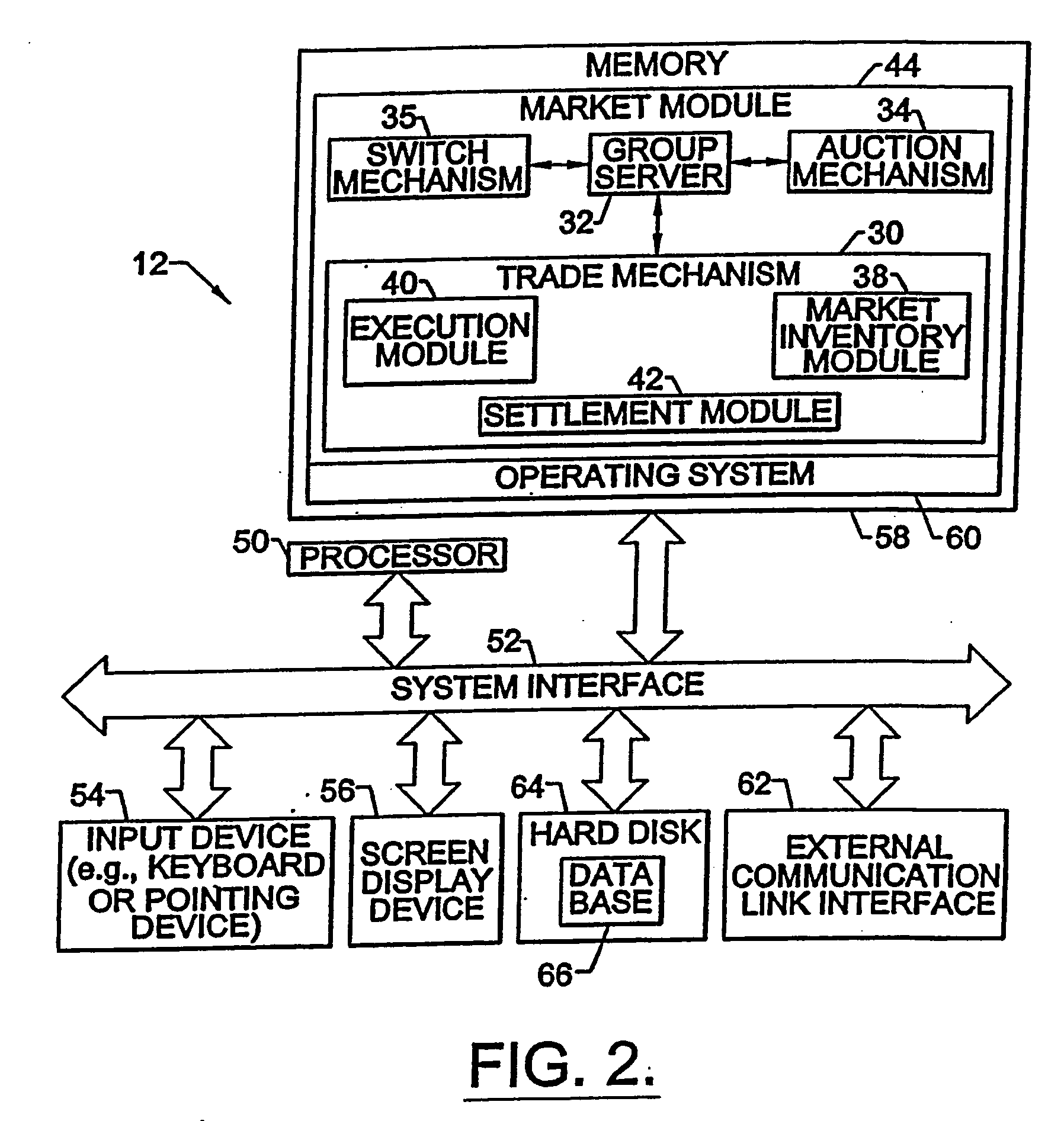However, because the markets in which these commodities are being traded are so vastly different from the descriptions of the instruments to transaction methodologies,
electronic trading systems are generally limited to a specific market such as futures, cash, oil, stock, securities, etc., and sometimes even to a specific commodity within a single market.
However, in an attempt to preserve the
anonymity of the parties, the
client sites may not have access to the credit limits set by their possible counterparties, or even to the identification of any other party to a particular transaction until after a transaction has been completed.
As a consequence, each
client site may not have the ability to determine, prior to committing to buy or sell at a displayed price from one or more anonymous counterparties, whether it is in fact eligible to respond to any of the bids or offers currently being displayed.
Consequently, unless a trader attempts to execute a trade at the best price currently displayed on the trader's screen, the trader using one of the anonymous matching systems may not know whether the trader has credit with, and is willing to extend credit to, the anonymous
counterparty offering (i.e., bidding) the best price currently displayed on the trader's screen.
Thus, the trader does not know whether any attempt to buy or sell at the displayed price may be subsequently invalidated by the
system for lack of such credit.
The Silverman et al. system also fails to provide for dialogue between the parties, much less anonymous dialogue which may facilitate the execution of a trade that might otherwise not occur.
The Togher et al. system is further limited by the fact that each
client site may provide the system with only limited credit information for each potential
counterparty (for example, a one bit flag indicating whether a predetermined limit has already been exceeded), and by the fact that each bid or offer for a particular type of financial instrument is apparently prescreened by the system for compatibility with that limited credit information before calculating an anonymous dealable price for presentation to the traders dealing with that particular financial instrument.
This may, however, add additional
time consuming steps for the users of the Togher et al. system.
Thus, individual orders are not independently treated, and the user may not have the ability to look through the bids and offers and deal at a worst price, if the user so chooses because of a difference in counterparties credit qualities.
In other words, in the Togher et al. system, the auto-matching process does not enable the active trader to select a price other than the best price to trade.
This may force the trader to accept what the system offers, even if the trader would prefer a different counterparty for credit reasons.
In addition, the Togher et al. system does not show the trader the total depth of the market, only those prices which are dealable, and thus, may fail to give the trader complete picture of the market.
The systems described above are such that they focus on overnight
settlement risk.
These systems are apparently incapable of dealing with the actual credit requirements of a variety of different individual financial instruments simultaneously and the counterparty's long-term ability to meet these requirements.
As a result, these systems have generally only been deployed in the markets where settlement takes place in a few days and there are no continuous or ongoing credit requirements between the counterparties.
Specifically, as a result of these limitations, these designs may not be able to
handle the anonymous trading of financial instruments such as interest rate swaps, caps and many other financial products.
They may be unable to accommodate these more complex financial instruments because, among other things, these systems apparently treat all financial instruments alike, and therefore, may be incapable of handling more complex financial instruments which require a judgment about the financial strength of the opposing counterparties.
Trades conducted with some financial instruments such as derivatives create multi-year financial commitments, and therefore, mere
credit limit or credit cap systems are insufficient means for measuring and managing an institution's credit risk.
Derivatives are considered by many to be too complex to be efficiently handled within an electronic trading system.
Yet another deterrence is the difficulty of determining a trader's position (i.e., interest risk position), and then identifying potential counterparties with offsetting positions for initiating a transaction.
No known electronic trading system has been able to do this on a real-time basis.
This factored with the wide spreads of exchange traded Eurodollar futures has made the use of exchange traded contracts for hedging short-term risks expensive and sub-optimal.
Despite the obvious advantages and demand from risk managers, the complexity and
time consuming nature of completing a transaction has resulted in this market growing rather slowly.
Risk managers are generally very wary of disclosing the exact nature and size of their own portfolios.
Therefore, finding a counterparty that has an opposite need is often difficult.
It is a
time consuming and costly task to collect the market information needed to determine a specific trader's own position within the market, much less to be able to identify potential counterparties with offsetting positions.
This deficiency of the prior art systems strikes to the essence of the derivatives market which is based upon large financial institutions to being able to manage their credit risk on a daily basis.
However, in derivative trading, counterparties may incur a multi-year financial commitment.
Thus, any system that automatically matches offers and bids without consideration of credit risk would be untrustworthy and inadequate from the perspective of a trader.
Thus, a heretofore unresolved need exist in the industry for an electronic trading system that automatically discovers the credit risk position of a trader for use in matching the trader with other traders having offsetting credit risk positions.
 Login to View More
Login to View More  Login to View More
Login to View More 


